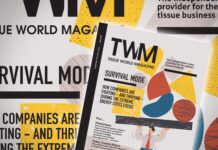To visit Japan, as I have just done for this issue’s Country Report, is both a sobering and inspiring experience. Sobering – in that Japan’s position in the world today is beset by profound problems.
First, an extended period of economic stagnation, somewhat dismissively referred to in the West as ‘the lost decade’; second, the terrible human and economic cost of a sequence of natural disasters culminating in the magnitude nine earthquake that struck on March 11 last year, unleashing a devastating tsunami that accounted for most of the destruction, including the potential multiple meltdown of three reactors at the Fukushima Daiichi nuclear plant; and third, potentially the gravest long-term problem – its ageing population.
Two TW reports make the economic situation clear. Fisher International’s Japan: An Economy Struggling to Recover, and Euromonitor International’s Japanese tissue sales take a battering as 2011 proves a year to forget.
Yet Japan was until recently the world’s second largest economy, and it took nothing short of phenomenal growth in China to overtake it. Its products are bought the world over and it is known for its quality across many sectors. It boasts a number of world leading companies in tech and manufacturing, to name two, which are among the best in the world.
Its banks have some of the lowest debts ratios in the world having exited their own credit crisis almost a decade ago and many of its firms are in rude health, being both conservatively run and cash generative.
And so it is inspiring because of the stoic nature of its people who have displayed a determination to rebuild and muddle through against the odds, whether that be facing the fallout of long term economic blight or rebuilding the country’s infrastructure after the devastating events of last March.
Tissue use as a barometer of a nation’s economic and cultural health is nowhere more clearly displayed than in Japan. No other country values hygiene so highly. Tissue products are everywhere: market traders on street corners hand out branded packets to passers-by; all meals are served with a wet wipe; hotels leave delicate scented tissues on reception desks; Japanese homes demonstrate a penchant and flair for hygiene products.
Tissue products and the delicate, precise nature of certain Japanese cultural traits are made for each other.
Demand for such high quality innovative products at the right price was evident from producers Doh-Ei Paper, Ehime Paper and Oji Nepia, visited by TW for our Country Report. And it would be rare for a crisis not to offer up opportunity for some. As a baby boomer generation moves rapidly into retirement without being adequately replaced, the demands on tissue manufacturers are taking a generational shift as they gear up to meet the many needs of an increasing number of elderly.
Japan is a unique and challenging market. Companies have had to cope with severe raw material and energy price hikes, along with changes to supply demands following the events in March as the future of nuclear power as a viable energy source has been questioned. Some firms have grouped together to save energy and in some cases this has included assimilated plant closures of up to 10 days.
Many of Japan’s issues are faced by countries around the world. This issue of TW offers an insight as to how all nations and their tissue producers can take advantage of opportunities amid tough trading conditions.
TW technology
TW also interviewed the world’s main tissue machinery manufacturers to get the latest on their technical and commercial know-how for this issue’s paper machine Technical Theme. Size, costs and energy consumption continue to dominate advancements. Gain a competitive edge by reading what they have to say. TW For all those whose New Year is covered by this edition, TW wishes you a happy and productive one.
In this issue, we preview the exhibitors and the event, which brings unparalleled opportunities to explore the latest developments, new ideas and opinion on the key challenges for the industry, and its very latest technology.


































